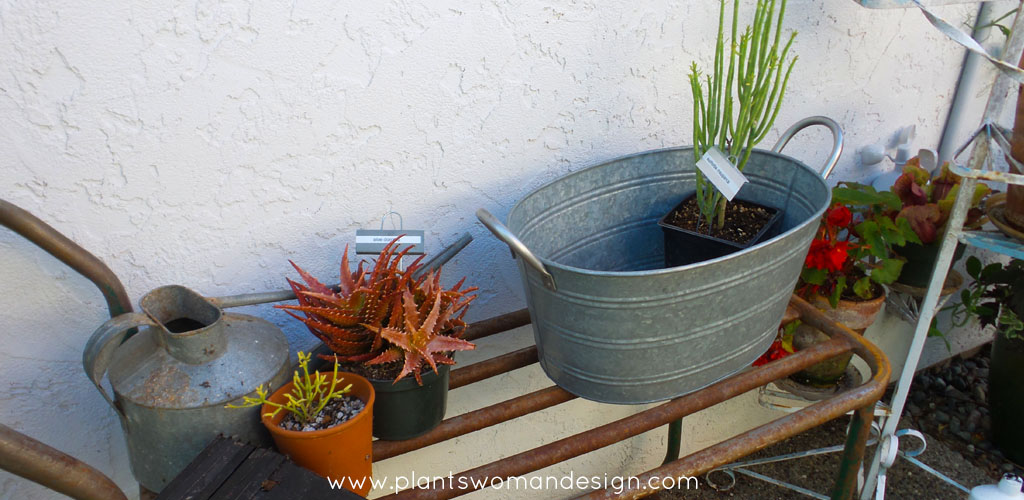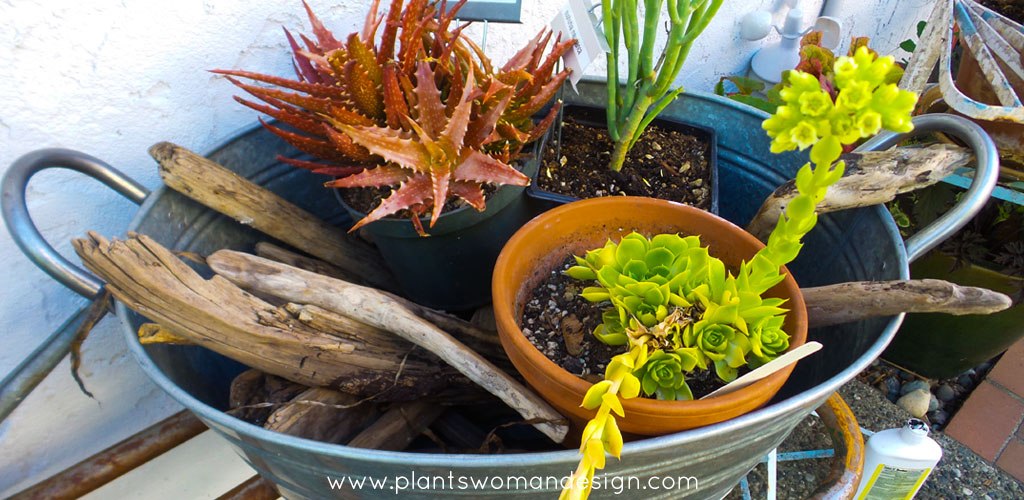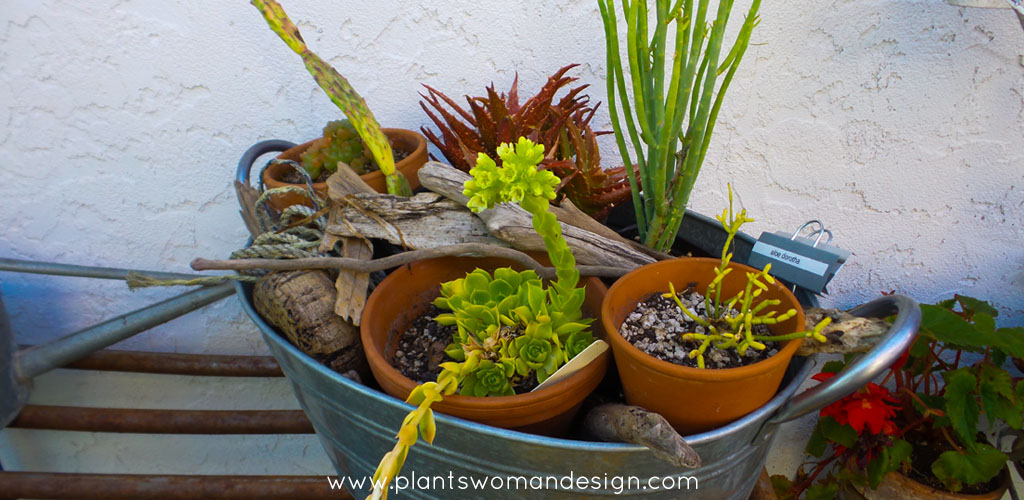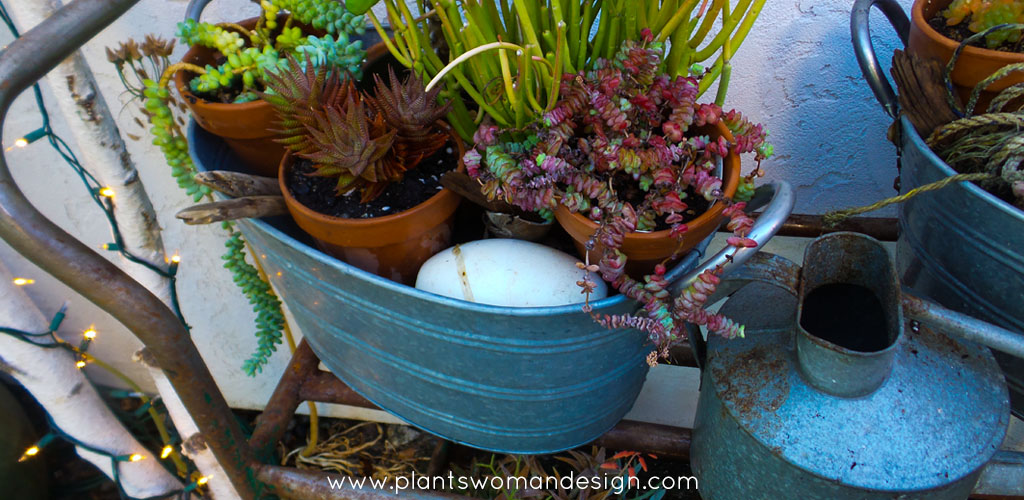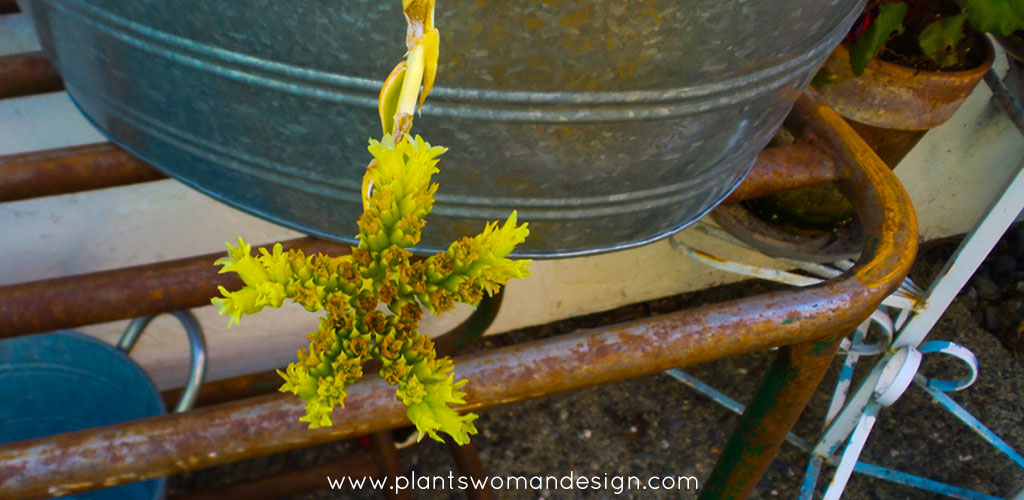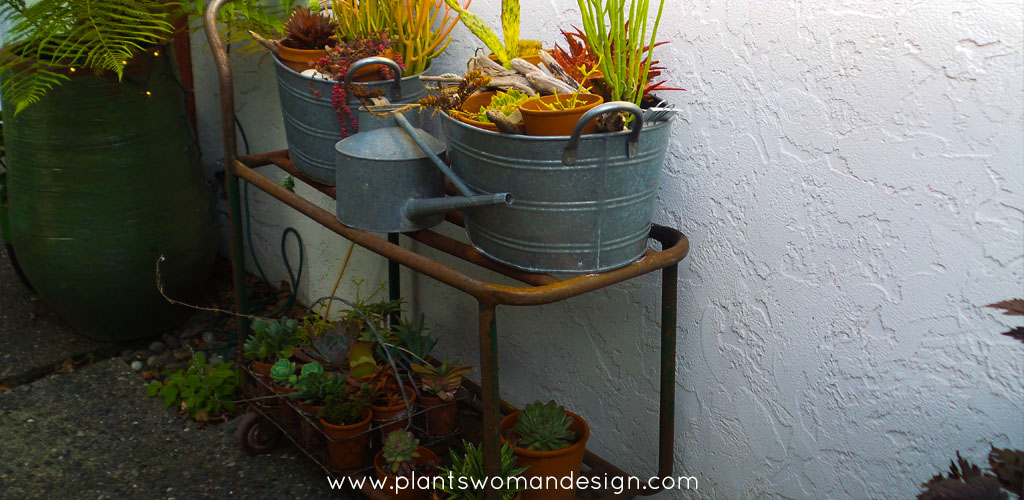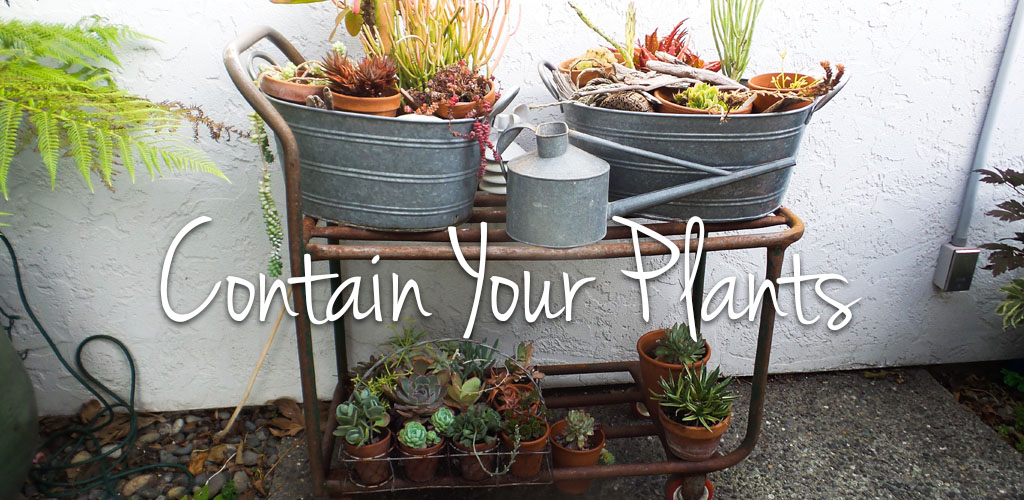
by Susan | Aug 21, 2015 | LB Tutorial: Container Gardening, Plantswoman Design
I don’t know about you but I have random collections of plants. I love succulents and I overwinter them in the greenhouse in small pots. When summer comes I’m ready to move them outside. BUT the very thought of having to water lots of small pots in odd places is daunting to say the least. So… a little pondering came up with a solution. I would use my collection as a vignette.
I purchased a couple of galvanized containers at a local store (TJMAXX).
Because I live near the beach I went and collected some driftwood and bits of beach debris. Because it is close and free I used it. You can use anything that is around you. If you live near a wooded area you can use old logs, branches, rocks, pretty much anything natural to create the interest around the pots.
I placed driftwood and debris under and around the containers. Using a couple of upside down plastic pots I elevated the shorter pots so they all are at approximately the same level. This creates easy watering and same type of sun exposure. The galvanized containers would hold water so I punched a small hole in them to allow excess water to drain out. If I ever wanted to reuse them and have them hold water I would just plug the hole with caulking.
Galvanized watering cans out of the greenhouse add to the display to finish it off.
Bringing the containers out and elevating them gives you a chance to see the interesting things in each plant.
Finished Display. Notice the old wheeled cart that the containers are sitting on? This allows me to move the plants around. When they first come out of the greenhouse they will get sun burnt if placed into direct sunlight. So, I move them from shade to part shade to more sun over a couple of weeks.
Smaller plants in an old plant pot carrier. This can be carried inside or placed on a table during a dinner then back out again. Versatility is the key here.
Join me on Facebook and share your succulent creations!
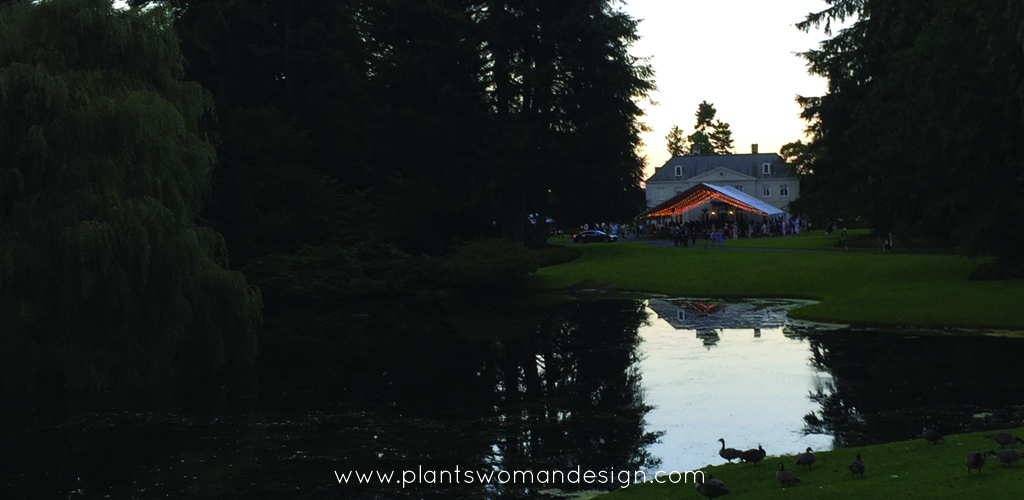
by Susan | Aug 8, 2015 | Plantswoman Design
As I walked through the Bloedel Reserve Thursday night I remembered the first time I came. Fresh out of school, I worked for Junkoh Haraui at Bainbridge Gardens where I started designing. As Junkoh and I talked he said in his gruff way ‘Go to the Bloedel Reserve, you will find out what gardening on Bainbridge Island is all about’. I went.
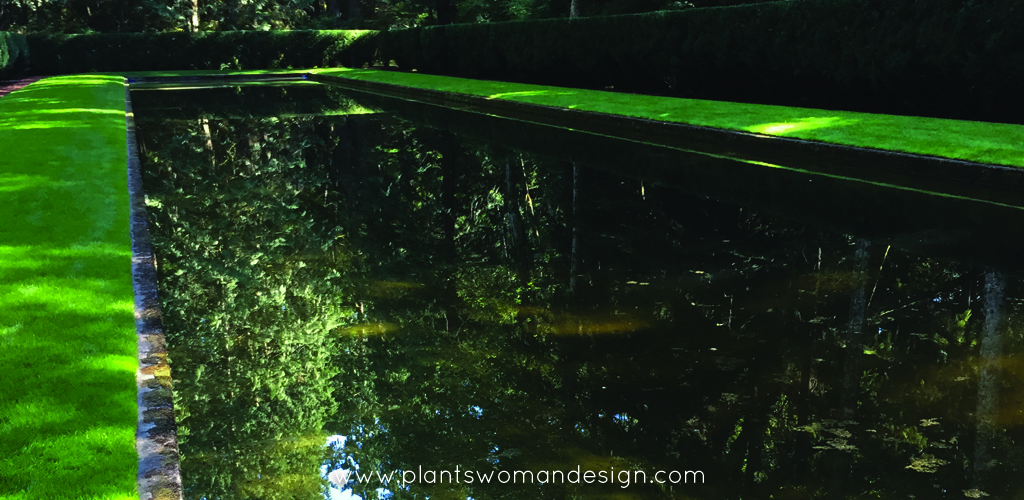
Amazement and awe were all I could say. Pathways wandering through beautiful groves of trees, a garden where moss was celebrated not killed and the beautiful natural pond with a weeping willow and geese were only the beginning. The birch trees with white trunks standing in a sea of salal still influence my designs today. And the peaceful, more formal, long reflecting pool still makes me pause and enjoy the vision of tree branches on the water seeming to lie on the ground. Reflected light, contained by hedging on all sides, creates a tableau that is arresting in its simplicity. The site of gravel raked into a pattern at the Japanese Garden was a first for me. The restraint in plantings and the way the individual trees are set apart and brought to focus also influences my design thoughts. I have since studied Japanese Gardens and understand and enjoy it more.
As I walked last night I wondered if I enjoy it more today or then. The newness of it, and the questions I had about what I was seeing were so numerous they overwhelmed me. I probably did not see the peacefulness or feel the calmness, as I should have, I just wanted to know more. My enthusiasm and inquisitiveness is what I really remember. WHAT was that plant!
Now after 15 years on the island, numerous trips to the Bloedel gardens, and studying the unusual plants there I know most of them. Gracious gardeners that know more than me shared their knowledge and love of the garden. Now when I walk through I do enjoy the peacefulness, calmness, and memories of people like Junkoh. I realize what a great gift Bloedel is and am amazed at a family that would and did leave such a legacy for generations to enjoy. It truly has been an inspiration to me from the beginning.
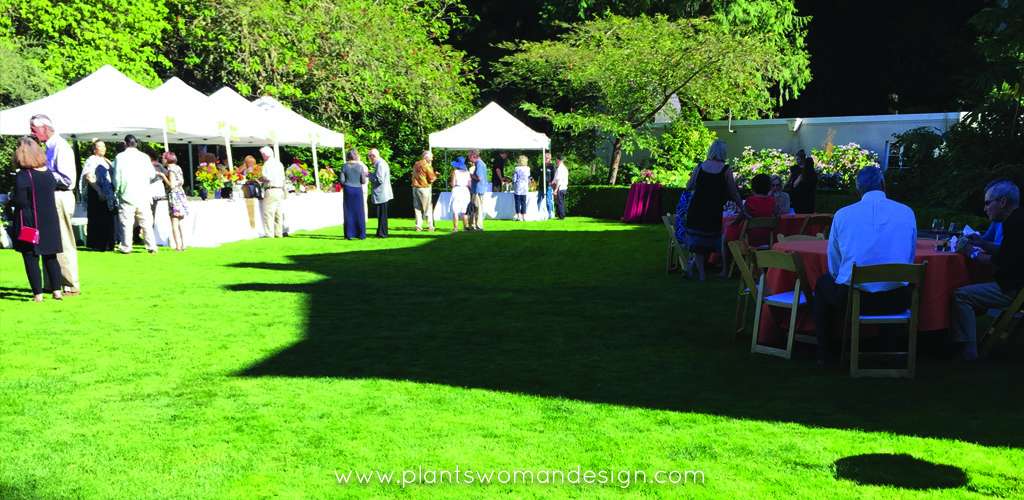
Last night I joined hundreds of people in raising money to fund important on going projects at the garden. Sponsors, wineries, and local restaurants gave of their resources to entertain and encourage the attendees. Individuals gave and purchased auction items. Enjoying the garden in that setting with like-minded people was indeed special.
If you have never been to the Bloedel Reserve Gardens you should go. No reservations are required and it is worth a special trip. If you are interested in attending next years Garden Party put it on your calendar. It is usually in August and you can sign up online to receive newsletters that will keep you posted on events. Support is always welcome but going and sharing the garden with others is the original purpose of the Bloedel family.
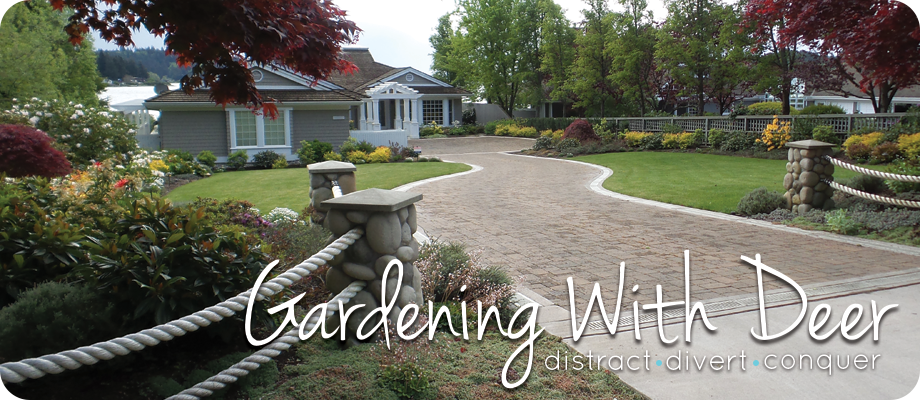
by Susan | May 15, 2015 | LB Tutorial: Design Challenge, Plantswoman Design
Many times clients ask me to design a deer proof garden. On Bainbridge Island there are many deer. They are so rough looking that they look like much loved stuffed animals. You may have heard the old adage that there is no such thing as a deer proof garden. And that can seem true as deer will eat anything if they are hungry enough. All you can really do is plan and experiment to see what works for your area. Sometimes deer at one end of the island will eat different things than the deer at the other end. I’ve seen them leave the hosta to be eaten by slugs (maybe they don’t like slugs either) and eat tender fern and rhododendron leaves. While at other places anything that looks like a hosta is eaten to the ground.
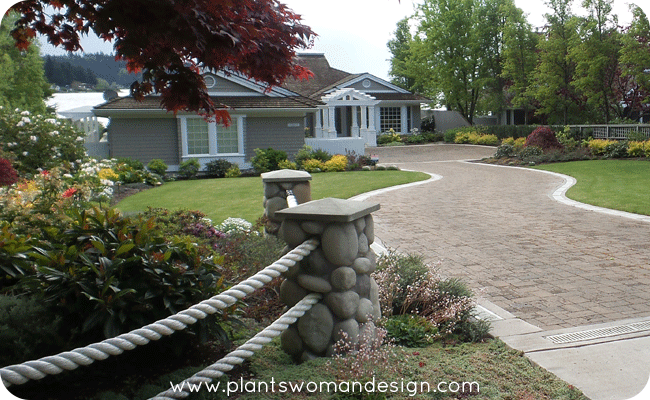 This is a beautiful coastal garden in the Point White area of Bainbridge Island. The clients are not here in the winter but come back in the late spring to the blooms I’ve planned for them.
This is a beautiful coastal garden in the Point White area of Bainbridge Island. The clients are not here in the winter but come back in the late spring to the blooms I’ve planned for them.
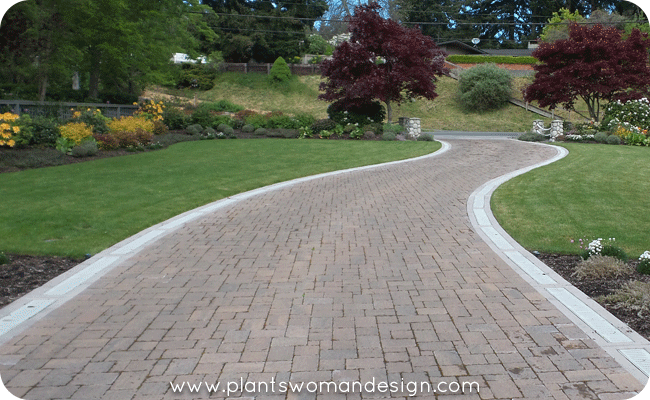 The paver driveway is good for the moist site and any excess water is directed down the edge drains. A combination of grasses, heathers, sedums are on raised berms to keep their feet from getting too wet.
The paver driveway is good for the moist site and any excess water is directed down the edge drains. A combination of grasses, heathers, sedums are on raised berms to keep their feet from getting too wet.
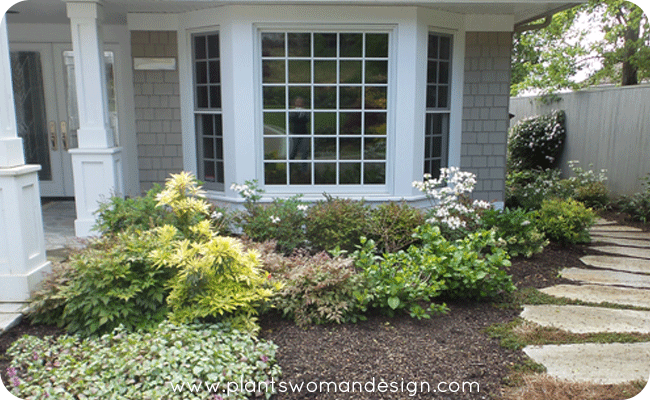 The owners requested evergreens and good blooms, they also love hydrangea (aka deer candy). We tucked these in close to the front door so they can be enjoyed and are less likely to be eaten. One thing the deer have eaten are the blooms off the Bergenia. The leaves are fine but the blooms are gone. Who knew?
The owners requested evergreens and good blooms, they also love hydrangea (aka deer candy). We tucked these in close to the front door so they can be enjoyed and are less likely to be eaten. One thing the deer have eaten are the blooms off the Bergenia. The leaves are fine but the blooms are gone. Who knew?
Here is my go to plant check list:
- Plants with fuzzy leaves like yak hybrid rhododendrons.
- Plants with strong fragrance like lavender, Sarcoccoca, and herbs
- Grasses (sedges really) with edges on the leaves.
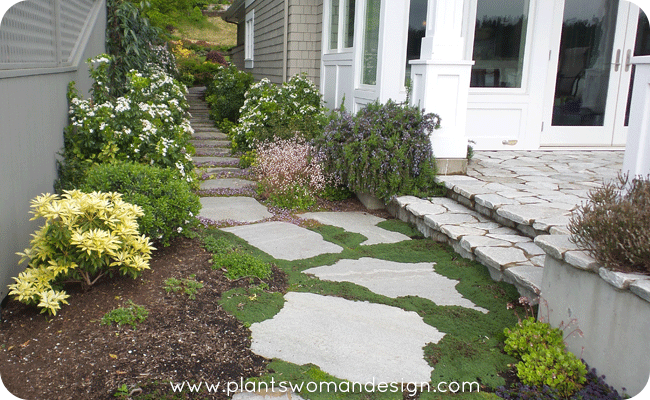 Design Tips:
Design Tips:
Plant ‘must haves’ like hydrangeas close to the house, by a tight side yard, near a patio or screen fencing. Deer like some hydrangeas better than others. Oakleaf will be eaten as soon as there is a leaf showing while paniculatas are often left alone.
Plant Roses on trellises so they bloom above the reach of deer.
Repetition is your friend. Planting something like heather, pine, or Hebe and repeating it gives a great look with less worry about feeding it to the deer.
Put out a couple of sacrificial plants to see what the deer might be eating in your area. You will soon know what their favorite food is. You can always bring it back to the greenhouse, holding area or give it away if you can’t place it.
Plant ‘deer candy’ surrounded by other plants deer don’t like. It often distracts the deer and they will leave it alone. I have one customer that has a beautiful oak leaf hydrangea surrounded by a belt of Berberis thunbergia – Red Barberry. Roses surrounded by Lavender also works.
Get a dog. Even non-aggressive dogs will keep deer away…. I’m just kidding really. Sometimes a digging romping dog is more trouble than the deer!
Share what you do to protect your plants from deer. Maybe you have a different problem like rabbits. They can be devastating too. What are your ‘go to’ tips for dealing with uninvited wild life?
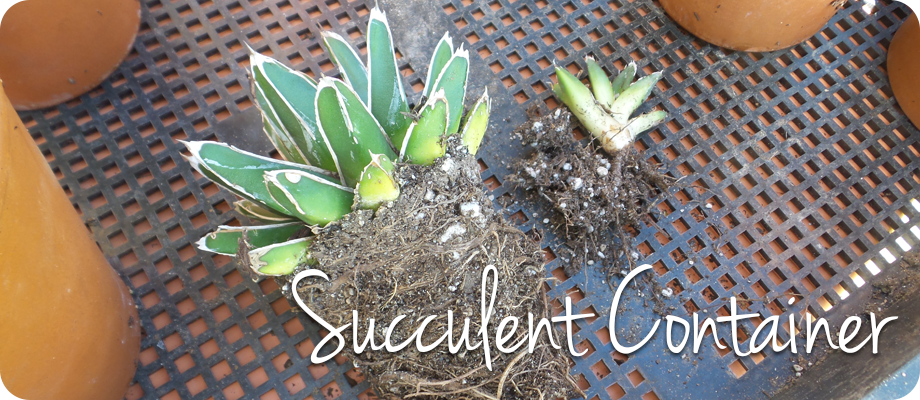
by Susan | May 8, 2015 | LB Tutorial: Container Gardening, Plantswoman Design
Succulents are all the rage right now. Every place I look, from the grocery store to the nursery, I see them. Many of them are not hardy in our area so they are treated like annuals. Surprisingly enough they are not hard to keep alive in your house with reasonable light and very little water.
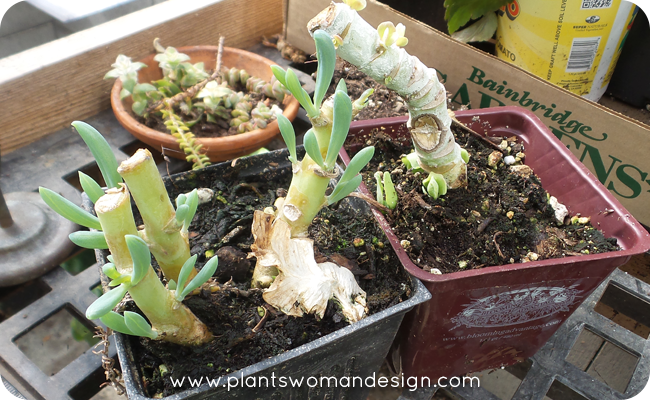 I hate to throw away plants so I try to keep them alive if I can. Now that the weather is getting better I’m ready to bring some of my previous saves back out. Sometimes I pick up a few more to add to the collection. Ready for a quick planting idea that you can engage your kids with?
I hate to throw away plants so I try to keep them alive if I can. Now that the weather is getting better I’m ready to bring some of my previous saves back out. Sometimes I pick up a few more to add to the collection. Ready for a quick planting idea that you can engage your kids with?
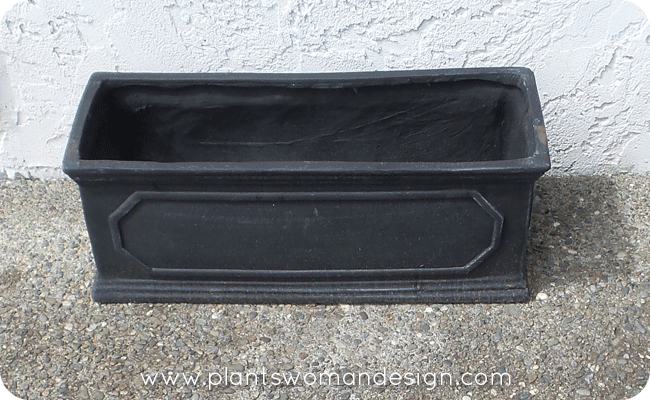 Lowes had a very lightweight rectangular planter. Just perfect for dropping some plants in! First I pushed out the plug in the bottom so the water would drain out. They come with a plug so they can be used as a water planter as well.
Lowes had a very lightweight rectangular planter. Just perfect for dropping some plants in! First I pushed out the plug in the bottom so the water would drain out. They come with a plug so they can be used as a water planter as well.
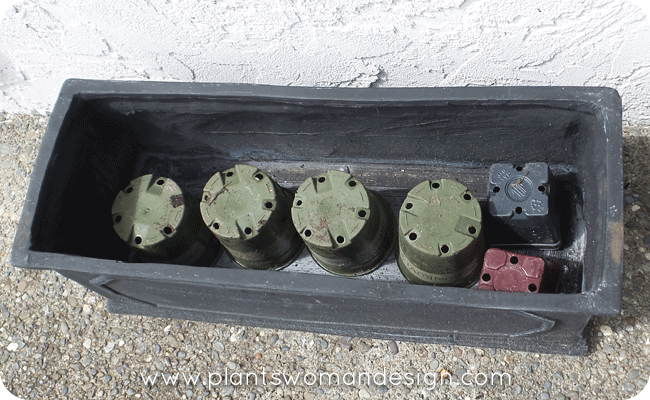 The succulents only need a small amount of soil to survive. The hardest part of keeping them alive is soil saturation from over watering. The way to use a deep container like this is to use a filler of some sort so the soil level is much less than the entire volume of the planter. I have used several types of filler but this time I’m using old 4-inch pots. Dropping them upside down inside the container will leave airspace beneath them and less room for soil above them.
The succulents only need a small amount of soil to survive. The hardest part of keeping them alive is soil saturation from over watering. The way to use a deep container like this is to use a filler of some sort so the soil level is much less than the entire volume of the planter. I have used several types of filler but this time I’m using old 4-inch pots. Dropping them upside down inside the container will leave airspace beneath them and less room for soil above them.
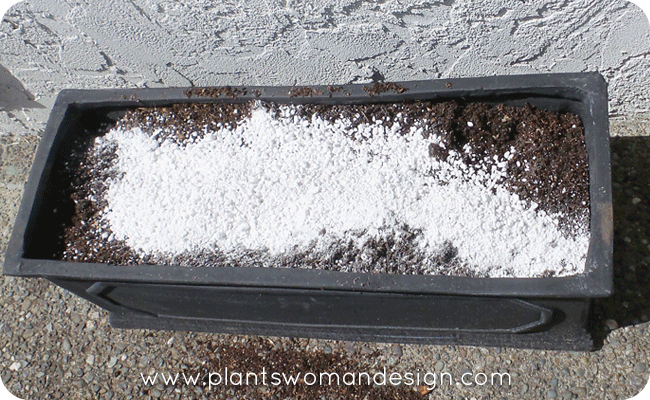 The soil used here is regular potting soil with extra perlite added to increase the air space in the soil. You can use a cactus mix but you can also mix your own soil from all purpose soil mix and adding different amendments.
The soil used here is regular potting soil with extra perlite added to increase the air space in the soil. You can use a cactus mix but you can also mix your own soil from all purpose soil mix and adding different amendments.
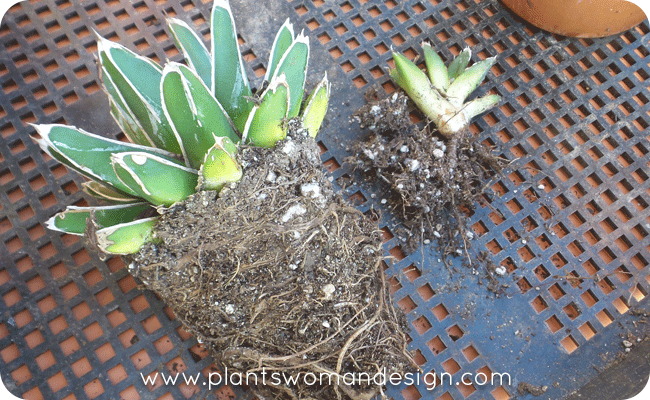
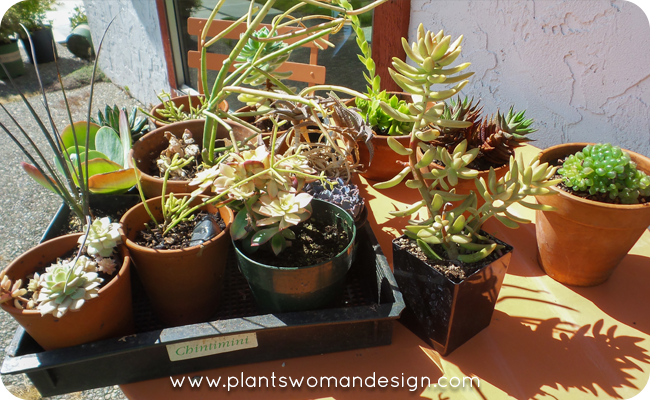 Using what I had over wintered with some new plants I created a little mini garden.
Using what I had over wintered with some new plants I created a little mini garden.  When planting try to plant contrasting leaves next to each other, putting tall things in the center or off center and build the contrasts around them. Firm the soil around the plants and soak the soil to settle it around the plants.
When planting try to plant contrasting leaves next to each other, putting tall things in the center or off center and build the contrasts around them. Firm the soil around the plants and soak the soil to settle it around the plants.
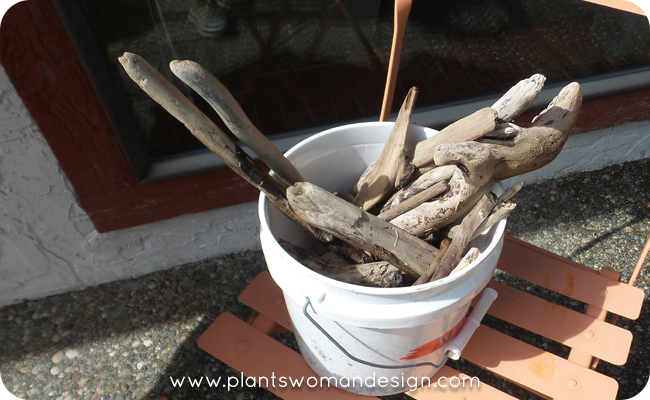 For the finishing touch I grabbed some pieces of driftwood, and shells from the beach. This is the perfect opportunity to have your kids help. My grand kids are always picking up rocks and sticks from their outdoor adventures and these collections can be added to the top of the planter to act as mulch. Ask your kids to add what they’ve collected on top of the soil. Rocks, sticks, beach glass, feathers, seedpods, whatever they come up with is so much fun. I usually have the worse time keeping my puppy from dragging out a couple of pieces to chew.
For the finishing touch I grabbed some pieces of driftwood, and shells from the beach. This is the perfect opportunity to have your kids help. My grand kids are always picking up rocks and sticks from their outdoor adventures and these collections can be added to the top of the planter to act as mulch. Ask your kids to add what they’ve collected on top of the soil. Rocks, sticks, beach glass, feathers, seedpods, whatever they come up with is so much fun. I usually have the worse time keeping my puppy from dragging out a couple of pieces to chew.
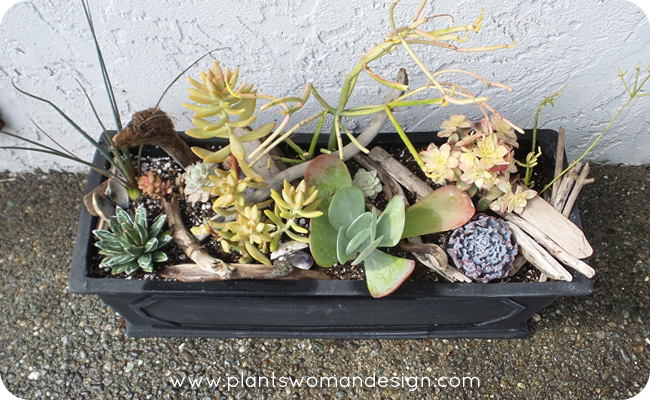 Do you have succulents? How have you displayed them?
Do you have succulents? How have you displayed them?

by Susan | May 1, 2015 | LB Tutorial: Skills, Plantswoman Design
Many of my clients have heard me say, “I don’t put it in your garden unless I’ve grown it myself.’ I am always experimenting and trying out new plants. After one Northwest Flower and Garden Show the sales rep from Encore gave me several varieties of Encore Azaleas. I tucked them into my garden and gave them a year to grow on to see how they survived a winter. Of the seven varieties I received, two did well, and five didn’t do so well. The ones that did well bloomed well, recovered from a cold winter, and looked good coming out of it. The five that didn’t do so well looked bad, they struggled through the winter and didn’t bloom. Because of this field test, I was able to add two azaleas to my pallet of plants which I still use today.
But, because of my field testing, my garden can look a little haphazard. Sometimes I will put a plant in two different areas to test drainage, hardiness, or sun/shade. Or plant three or more of the same species of plant in various colors together. Experimentation is exciting when plants that are not hardy survive, unexpected color combinations present themselves, and learning that not giving a plant everything it wants keeps it under control. Dead plants will always be a design flaw. Invasive plants are also a design flaw.
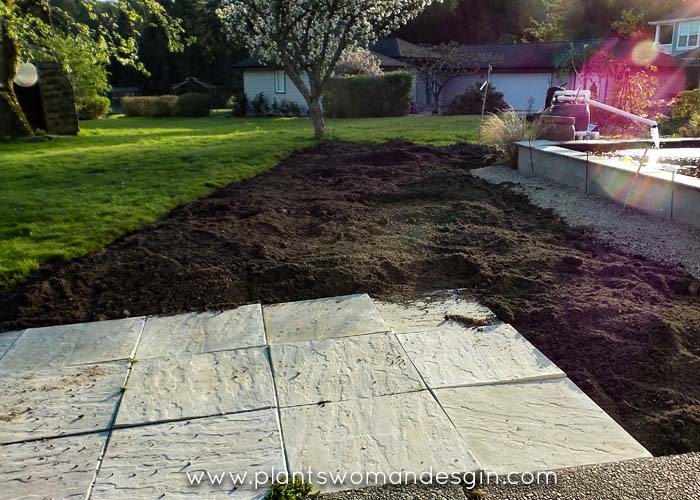
Pictured above is a newly created bed in my garden. As I contemplate the design for this bed, I’m taking a walk in my client’s shoes. The result is a design that would satisfy many of my customers. Striving for a minimal color pallet in leaf color, bloom and texture it looks and will look amazing. All the foliage in the bed is bright green and blue-gray. The flowers will be either white or lavender and blue. I dropped in three contrast plants to make the bed continue to pop in the late summer. A gray leafed Lobelia tupa with a brick red flower, and colocasia sangria, a gray leafed elephant ear with a red stem, and a low groundcover geranium ‘Hocus Pocus’ with a dark red leaf and blue flower.

Here’s how I planned this bed along with 5 useful tips for designing your garden bed.
1. Choose for height. There are higher plants in the center with graduating heights toward the edges. The far end of the bed has a taller section with an evergreen Eriobothrya japonica (Loquat) for screening from the neighbor.
2. Choose evergreen, deciduous, and perennial plants. I want to be sure that the bed looks good year-round. This bed is right in front of the window that looks towards the koi pond. So I made sure to strike a balance between all the elements so there are no big blank spots that would show up in the winter or summer because of dormancy.
3. Choosing color and texture. I pay close attention to the play of texture and color in leaves. The balance of texture between the Carex ‘Evergold’ and Stachys Bella Grigio’s blooms is just as exciting as the contrast in leaf color. The spikes of Agapanthus ‘Blue Leap’ between Lavender ‘Richard Gray’ and Spirea ‘White Gold’ are also an exciting combination.
4. Bloom time. Surprising enough, the last thing that gets consideration from me is the flowers. Because there are so many great plants to choose from, it is easy to get the flower color right. Early blooms from the geranium and the campanula ‘Dickensens Gold’ will be the first to show here. The Agapanthus, Lavender, and Centaurea simplicicaulis will be next. Later season blooms will be Caryopteris ‘Dark Knight’, Salvia elegans ‘Gold’ and the Lobelia Tupa.
5. Site considerations (AKA where is the sun). Usually, this is pretty easy to define. Sometimes you can add something that likes shelter behind something more prominent. The Lobelia tupa wants to have shelter, so I planted the Pittisprorum ‘Blue Wave’ between the water and the lobelia. This arrangement should protect the lobelia from the brunt of the weather.
Variations in the number of plants are flexible and entirely up to the designer. Repetition of plants creates rhythm and looks natural because, in nature, plants do seed around and create groups.
Plant List for Hot and Bright!
Lobelia Tupa, Caryopteris ‘Dark Knight’, Agapanthus ‘Blue Leap’, Spirea ‘White Gold’, Geranium ‘Hocus Pocus’, Campanula ‘Dickenson Gold’, Carex ‘Evergold’, Colcasia ‘Sangria’, Lavender Richard Gray, Centaurea simplicicaulis, Salvia elegans ‘Gold’, Pervoskia atripicifolia, Stachys ‘Bella Grigio’, Saxifraga crustata, Salvia nemerosa ‘Blue Marvel’, Panicum ‘Ruby Ribbions’.
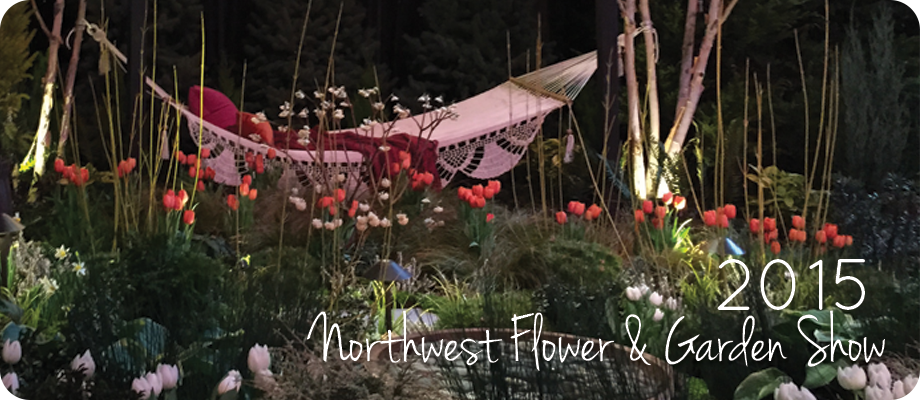
by Susan | Feb 14, 2015 | Plantswoman Design
It is garden show time and while Plantswoman Design didn’t create a display garden we attended the show enjoying our role as observers. We would love to share what we loved with you.
First the gardens…
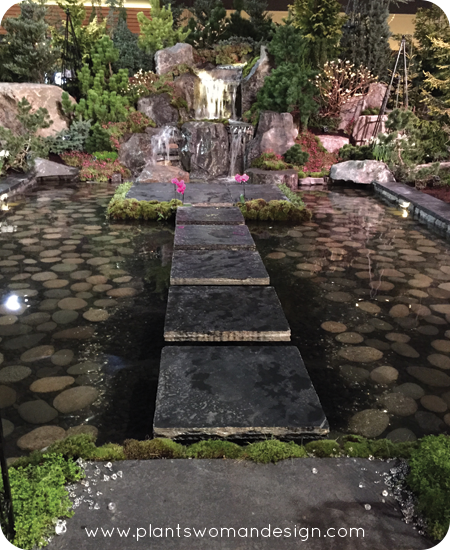
This garden was titled ‘A moment to remember’. Nature Perfect Landscaping did a great job of creating a mystical setting for a wedding. The fabulous water fall in the background with the mountainous rocks made it seem like you were in a grotto in the wilderness. I loved the ‘floating’ platform and steps.

Susan Browne did a fun rendition of ‘Love the Space You’re In’. Love the orange with contrasts of blue. I wanted the chairs. (designer secret Lowes, Thanks Susan Browne).
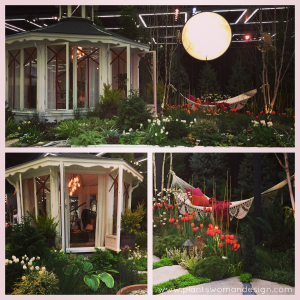
Over the Moon was over the moon and took top honors this year. The restricted palate was great with white and green taking center stage. Susie Thompson did a fabulous job mixing textures and colors of plants with the hardscape elements. A Swedish gazebo was a beautiful touch. Thanks ADLP for this great design and installation.
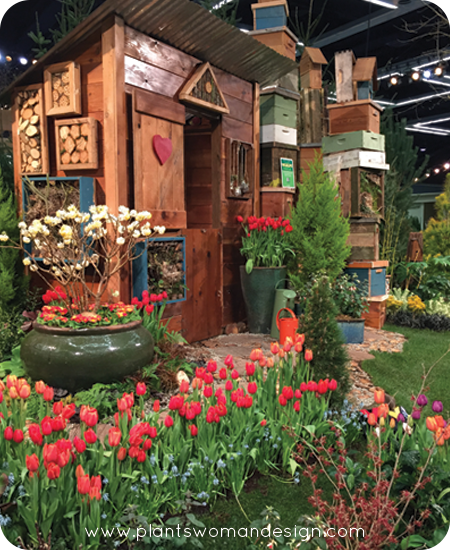
Two Nurseries joined the garden floor this year. West Seattle Nursery had a eclectic and interesting garden with lots of levels for birds and bees. The fun use of wooden bird houses and bee hives with the plants was great. They had a choice peach tree in the front.
The theme this year was “Romance Blossoms”. There was A LOT of PINK. I mean A LOT !!
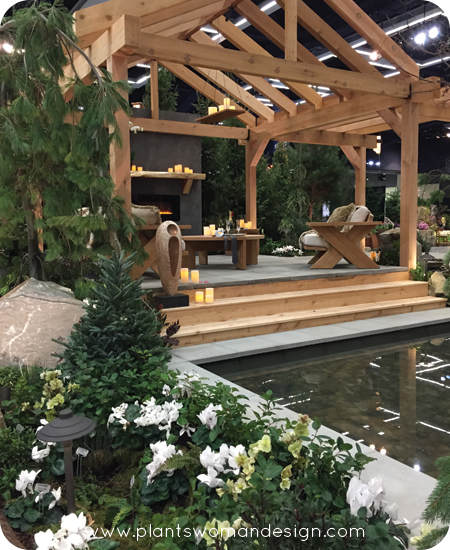
Thank goodness Karen Stefonik ran counter to all the pink at did a masculine take on the theme. Big beams ran across the space and the large scale of the furniture and fireplace made it a place you wanted to hang out in. The reflecting pond gave a quiet soothing view surrounded by the restricted colors of white and green. (designer secret Costco for the fireplace).
What I Missed This Year:
Good Rare and unusual plant nurseries. Our local Plantsman Nils Sundquist was there and Keeping it Green Nursery was there but I was missing Kelly from Far Reaches, and Edelweiss Plants from Oregon. I love the good unusual plants.. Hoping they come back next year.
I missed seeing all my customers and friends as they came to visit my display. It is always fun to have friendly faces in the crowd when you are in a big display garden.
Cyle, the previous show director has moved on to different things. It was sad to see him go last year and I missed his unflappable personality and dry wit. “How bad is it leaking…? That’s ok just mop it up and see how it does.” “The tree house fell down in the middle of the night. I wonder if anyone heard it?”
Edibles. This apparently was not the year of the chicken, goat, or vegetables. Usually we get to enjoy the garden creators tucking in a small veg garden and helping us to remember sustainable landscapes and self-sufficiency of growing our own food.
What Was New:
Family Farm Center – Located in the back hall was an interactive farm for children. It was sponsored by Farmer Frog, the creators of Urban farming programs in the Puget Sound. It was good to learn about the fight to feed the hungry in our area. 1 in four children go to bed hungry in our area each year. Check out their website for ways to learn about the process and ways to help.
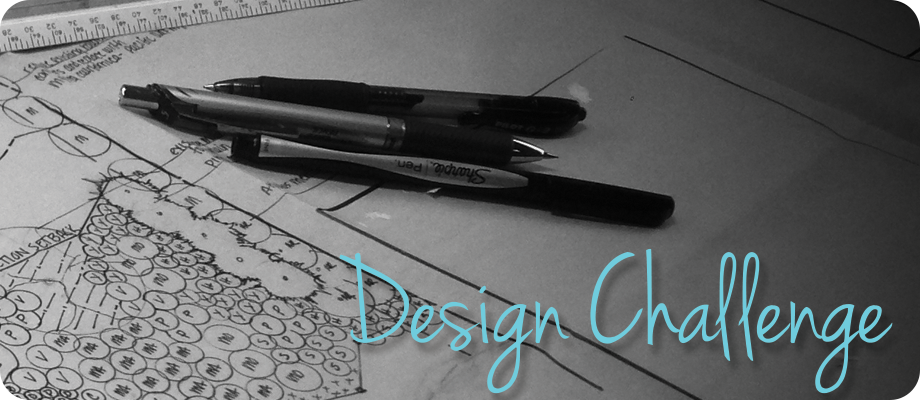
by Susan | Dec 12, 2014 | Plantswoman Design
I get the opportunity to design many gardens for many different reasons. Sometimes the parameters are set by owners, sometimes they have to meet strict standards set by a public entity. It is always fun to have a limited pallet to work with. Recently I was asked to design a buffer between a new house and the shoreline using only native plants. Restrictions about shoreline plantings are becoming more stringent in our area and many different city departments have a say in what you can plant so that makes it challenging. Because of this it is always a good idea to hire a landscape designer to help with this type of challenge.
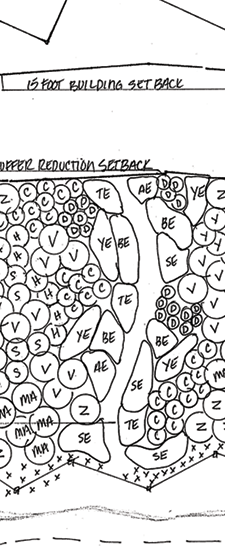 The owners originally hired an engineer to design the plan for the buffer area. However, the plantings that the engineer had planned would eventually have obscured the view to the water. After all the reason for building a house by the water is for the view! Instead of having large trees across the shoreline I pushed the larger trees and shrubs on the edges of the property and gathered lower native plants towards the center. A bench at the end of the path near the edge of the bank gives a place to sit and watch the changing sea. The required split rail fence along the edge of the bank is a low barrier to keep people from getting to close to the edge and falling. Planting native Elymus grass helps to hold the bank and give great movement and color.
The owners originally hired an engineer to design the plan for the buffer area. However, the plantings that the engineer had planned would eventually have obscured the view to the water. After all the reason for building a house by the water is for the view! Instead of having large trees across the shoreline I pushed the larger trees and shrubs on the edges of the property and gathered lower native plants towards the center. A bench at the end of the path near the edge of the bank gives a place to sit and watch the changing sea. The required split rail fence along the edge of the bank is a low barrier to keep people from getting to close to the edge and falling. Planting native Elymus grass helps to hold the bank and give great movement and color.
Using a mixture of herbaceous and evergreen low growing plants helps with the preserving the view to the water. Sedums, grasses, and camas line the pathway to the bench. Take a look at the plant list below which represents the required plant quantities and the percentages of evergreen and deciduous for the space.
Do you have special challenges with your garden?
************************************************************************

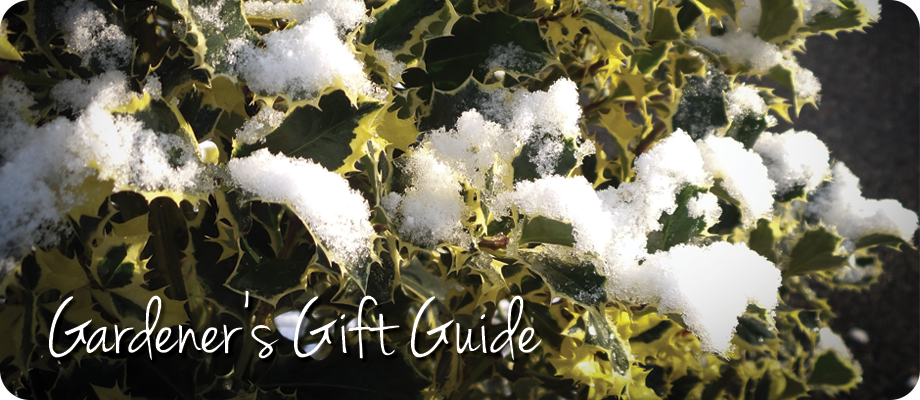
by Susan | Dec 5, 2014 | Plantswoman Design
Every year people ask me what to get me for Christmas, sometimes I say and sometimes I don’t. It is always interesting to see what I get and I think if you have a list it takes the surprise out of it. Of course, there are a few in my family when a list is necessary, but for the most part I’d prefer to have the surprise. This year I thought it might be fun to put together a list of my favorite garden things. The gardener’s in your life will love them too.

First on my list is about — Food – I love to eat so I cook. One of the best books I found this year is about gardening, growing, cooking and eating (all my favorite things). Grow Cook Eat: A Food Lover’s Guide to Vegetable Gardening, Including 50 Recipes, Plus Harvesting and Storage Tips by Willi Galloway is a great book for gardeners and cooks. I love that it can help you plan your veg garden for the next year and recipes that will inspire you to grow what you want to cook in your kitchen. This book has great advice on how to plant, harvest and store , plus 50 good recipes. Check out Willi’s website at www.digginfood.com.
by Willi Galloway is a great book for gardeners and cooks. I love that it can help you plan your veg garden for the next year and recipes that will inspire you to grow what you want to cook in your kitchen. This book has great advice on how to plant, harvest and store , plus 50 good recipes. Check out Willi’s website at www.digginfood.com.
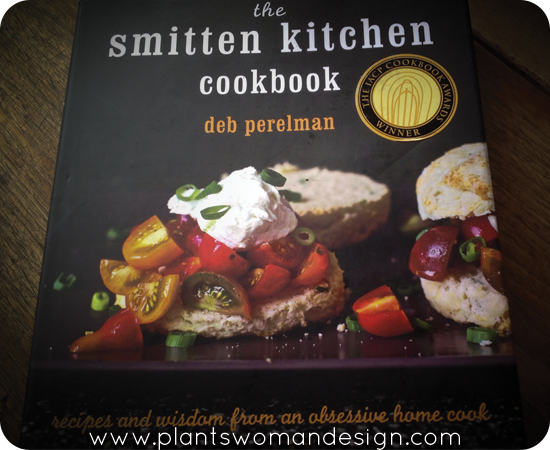
Next on the list is also about food – Humm might be a theme here. The Smitten Kitchen Cookbook is another book I’m in love with this year. Deb Perelman has written a story of her life with a recipe commentary. Her Mom’s apple cake is amazing (yes I still have apples) and the Wild rice gratin even makes Kale taste fabulous. Sometimes I do ingredient based cooking. I find something interesting at the grocery and then look for a way to cook it. This book uses everyday things in the cupboard and then adds a twist . Makes you seem like a fabulous cook and it was really easy.
is another book I’m in love with this year. Deb Perelman has written a story of her life with a recipe commentary. Her Mom’s apple cake is amazing (yes I still have apples) and the Wild rice gratin even makes Kale taste fabulous. Sometimes I do ingredient based cooking. I find something interesting at the grocery and then look for a way to cook it. This book uses everyday things in the cupboard and then adds a twist . Makes you seem like a fabulous cook and it was really easy.
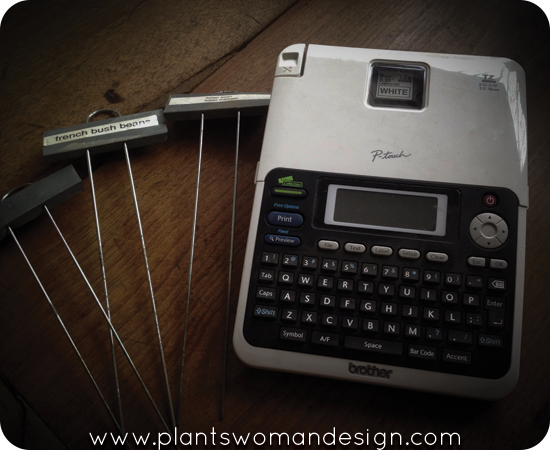 Now for a practical gift… I am a practical person as well and I know gift givers who just have to give something practical. They want it to be ‘useful’. For those people out there I present to you one of the best things for garden labeling. I like to label things in my garden. No, not everything, but I do mark where I planted bulbs and what they were, vegetable rows so I don’t dig over them and species plants so I don’t forget what they are. I also keep records on plants so I know how they do but If I can’t remember them or read the tag it gets very frustrating. Here is my label maker, it is a Brother P-Touch PT-2030 Label Maker
Now for a practical gift… I am a practical person as well and I know gift givers who just have to give something practical. They want it to be ‘useful’. For those people out there I present to you one of the best things for garden labeling. I like to label things in my garden. No, not everything, but I do mark where I planted bulbs and what they were, vegetable rows so I don’t dig over them and species plants so I don’t forget what they are. I also keep records on plants so I know how they do but If I can’t remember them or read the tag it gets very frustrating. Here is my label maker, it is a Brother P-Touch PT-2030 Label Maker . Beside it are a couple of labels. You can see one of the markers has no name….. oh … I did have a name but I can’t read it after just one season. It was marked with the pencil that came with the marker. I have also tried felt markers with the same result. The labels on the other ones are 3 years old. I can change them easily or use them again if I grow the same things. This one is battery operated with an automatic turn off so I can take it outside. Cool!
. Beside it are a couple of labels. You can see one of the markers has no name….. oh … I did have a name but I can’t read it after just one season. It was marked with the pencil that came with the marker. I have also tried felt markers with the same result. The labels on the other ones are 3 years old. I can change them easily or use them again if I grow the same things. This one is battery operated with an automatic turn off so I can take it outside. Cool!
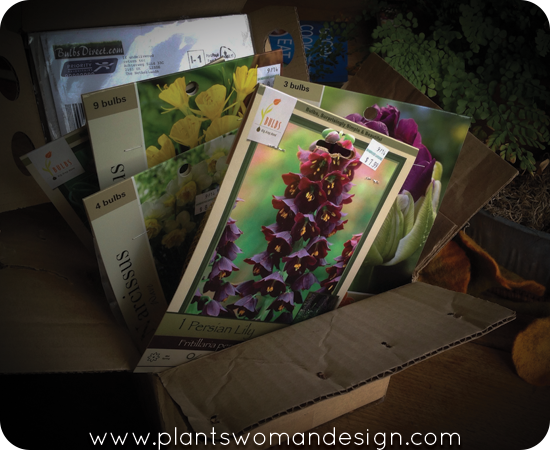
How about a “Box of Color”? I love to give and receive plants. Plan a couple of surprises for the gardener in your life by looking online or at the nursery for something interesting. Bulbs can be purchased and put in refrigerator at 40 degrees and given on Christmas. Vegetable Garden Seeds that are unusual can be purchased and put together with one of the above. I like to order seeds of things that people have commented on in my garden and give them to as gifts. I just got a box from the Netherlands just the other day that contained Crocus sieberi sublimis Tricolor and just the box was so cool! It came from a very long ways and can be planted in my garden!
Need ideas for what to buy? Check out my post on Winter Bulbs, Fall Bulbs, Spring Bulbs, Fall Into Spring. Keep in mind planting times and such. Feel free to ask me any questions you may have.
And now we come to… Power tools. Really, really. Two of the most amazing power tools I have are a Ryobi P515 ONE Plus 18V Cordless Lithium-Ion Reciprocating Saw w/ Anti-Vibe Handle and Toro Electric Blower/Vacuum with Metal Impeller
and Toro Electric Blower/Vacuum with Metal Impeller . Years ago I would use the cordless saw for pruning. I would go into the hardware store looking for blades that would be long enough for big branches. The clerks would ask me what I was doing with it. Then they would laugh and say ‘You can’t use that for pruning’. Really? Well somehow the manufacturers caught on and now they make blades for pruning. It is so light weight that you can stand on a ladder and use it with ease. Your arm does not feel like it will fall off from the sawing motion of a hand saw. Don’t forget the battery! If you have Ryobi or Dewalt tools already you are set but if you don’t make sure to get a Ryobi Compact Battery
. Years ago I would use the cordless saw for pruning. I would go into the hardware store looking for blades that would be long enough for big branches. The clerks would ask me what I was doing with it. Then they would laugh and say ‘You can’t use that for pruning’. Really? Well somehow the manufacturers caught on and now they make blades for pruning. It is so light weight that you can stand on a ladder and use it with ease. Your arm does not feel like it will fall off from the sawing motion of a hand saw. Don’t forget the battery! If you have Ryobi or Dewalt tools already you are set but if you don’t make sure to get a Ryobi Compact Battery too.
too.
The leaf blower with a mulch attachment was a hard sell to me. I don’t like the noise of the blower. (lots written about noise pollution ). But faced with a huge amount of paved surfaces and really tired of sweeping I purchased the Toro Electric Blower/Vacuum with Metal Impeller . It is powerful so it blows the gravel, dirt and leaves. After the leaves are in a pile It can be used to suck them up and chop them into pieces and put in a bag. I love that. You can add to compost, cover plants or throw away. Better than burning them or having them piled only to blow all over again!
. It is powerful so it blows the gravel, dirt and leaves. After the leaves are in a pile It can be used to suck them up and chop them into pieces and put in a bag. I love that. You can add to compost, cover plants or throw away. Better than burning them or having them piled only to blow all over again!
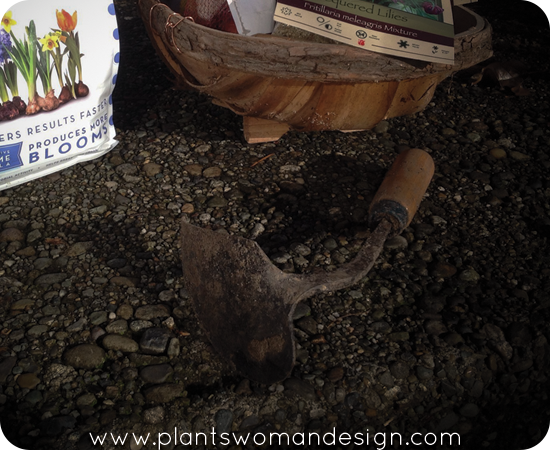
Last but certainly not least is this Hand Plow Ho-Mi EZ Digger , sometimes known as a Korean Cultivator, that is my go to tool when digging in the garden.
, sometimes known as a Korean Cultivator, that is my go to tool when digging in the garden.
Have fun shopping for the gardener in your life. Share this post with those who will buy for you (it’s not exactly a list), or plan for what to get with the return of that unwanted present from your Great Aunt.
*disclaimer: affiliate links are used in this post.
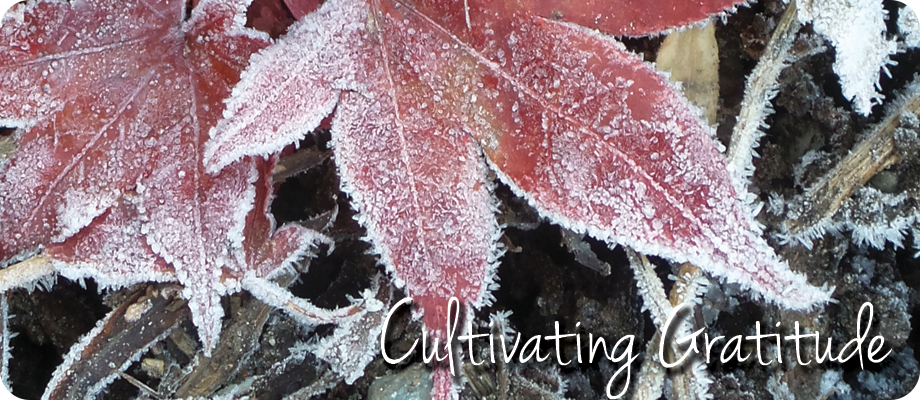
by Susan | Nov 28, 2014 | Plantswoman Design
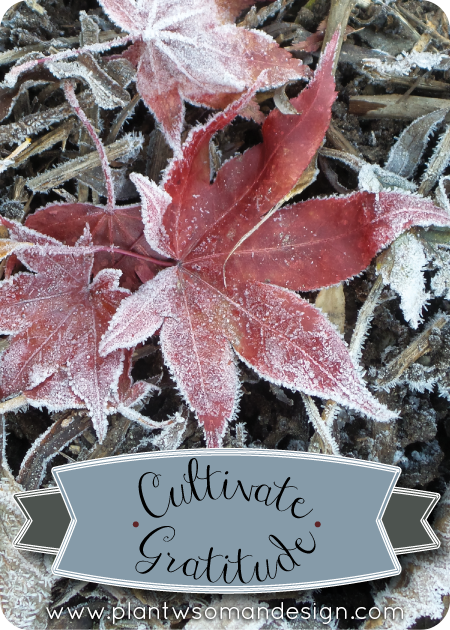 Autumn is such an amazing season. The tumultuous growth and color of summer is fast fading. We had such a long summer and winter jumped into fall before we (and the plants) were ready. Many plants still in full green leaf were surprised by the quick and hard freeze. Just like our plants this year, sometimes we are surprised by things that happen in our lives. New adventures, new directions and different ways to look at things, are often just around the corner.
Autumn is such an amazing season. The tumultuous growth and color of summer is fast fading. We had such a long summer and winter jumped into fall before we (and the plants) were ready. Many plants still in full green leaf were surprised by the quick and hard freeze. Just like our plants this year, sometimes we are surprised by things that happen in our lives. New adventures, new directions and different ways to look at things, are often just around the corner.
This past year has been a season of change for me. Looking forward to the year that lies ahead of me I want to cultivate gratitude. Looking past the changes in my life and really seeing what is around me. Looking at the sky and realizing that those clouds may never look exactly like that again. Seeing the beauty in small things, colors in the dying maple leaf and watching as an eagle stops and perches above the water near me. Touching the earth and knowing the amazing possibilities in the soil. Seeing the face of a person and wondering what their story is and who they love. Taking the time to see people walking by and reaching out a hand to help, share or understand their journey. Cherishing and cultivating the warmth of love given freely.
Gratitude cultivated is my goal for this coming year, to really see the nature around me, to cultivate my appreciation of the beauty in everyday things. I want to see relationships and people grow and mature, share their joy and sorrow and not look away.
Thank you for being a part of my life, for sharing your lives with me, treating me like family and laughing with me. Here’s to a new year of gratitude!

